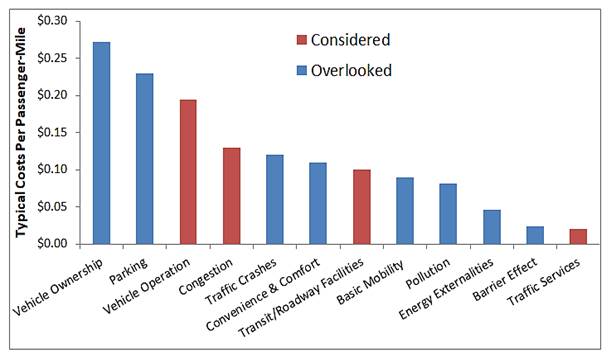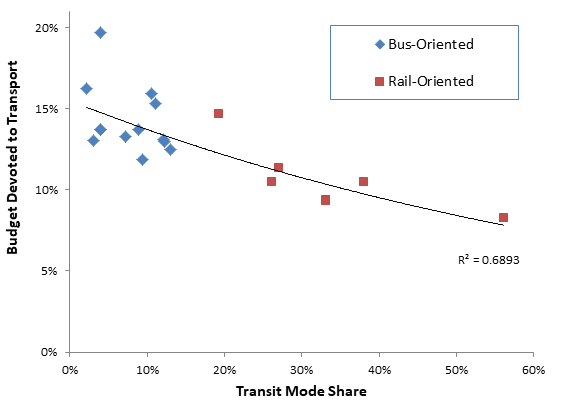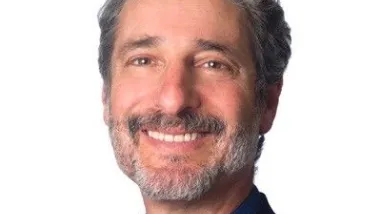Critics often use fallacious arguments and inaccurate evidence to attack public transit and Transit Oriented Development. Here are suggestions for responding to their false claims.

My recent column, Multimodal Transportation for Economic Freedom, Opportunity, and Security, described many reasons to create more diverse, and therefore more efficient and equitable, transportation systems. Improving active and public transport allows people to choose the best option for each trip – walking and cycling for local travel, public transit for travel on busy urban corridors, and automobiles when they are truly most efficient, considering all impacts. Everybody benefits, including motorists who enjoy less congestion, accident risk and chauffeuring burdens. What’s not to like?
Not everybody agrees. Multimodal planning is often attacked by a small but vocal group of critics. They use incomplete and biased information to make investments in alternative modes, particularly rail transit, seem wasteful and unfair. My new report, Evaluating Public Transit Criticism: Systematic Analysis of Political Attacks on High Quality Transit and How Transportation Professionals Can Effectively Respond, reveals these tricks.
High quality public transit provides large and diverse benefits, including direct benefits to users and indirect benefits to other community members. This is both a strength and a weakness. Critics exploit this diversity of benefits to create doubt and conflict: they attack urban rail that attracts drivers, and therefore reduces traffic problems, as being unfair to disadvantaged people; they attack basic bus services that provides basic mobility for non-drivers for being slow and ineffective at reducing traffic problems; and they attack Transit Oriented Development for the long time required to transform communities and achieve its ultimate goals. Clever critics assemble facts and examples that support these attacks, and use this to sow division among potential transit allies, for example, pitting anti-poverty advocates against urban rail, creating doubt that transit improvements reduce congestion and emissions, and encouraging urban residents to oppose TOD as a threat to their community.
However, this diversity is also an opportunity. Advocates can apply more comprehensive analysis showing that, although transit is not necessarily the best way to achieve any single goal, it is often very cost effective considering all impacts. This diversity of benefits provides an opportunity to build coalitions in support of high quality transit and TOD based on shared goals.
A good example of inaccurate and biased transit criticism is Wendell Cox and Joel Kotkin’s recent report, The Great Train Robbery: Urban Transportation in the 21st Century, which claims that rail transit is expensive, ineffective and unfair. Their arguments typical of those used by critics to exaggerate the costs and understate the benefits of high-quality public transit and Transit Oriented Development. Let's investigate their tricks.
Cox and Kotkin’s basic thesis is that outside a few “legacy” transit-oriented cities with dense central areas, rail transit is outdated and wasteful. They argue that automobile dependency and sprawl are inevitable, efficient and desirable, which ignores surveys showing growing consumer demand for housing in more compact and multimodal communities. They assume that development patterns are static, which ignores efforts by many communities to become more compact and multimodal; in fact, some of the greatest beneficiaries of rail system expansions are suburbs such as Lakewood outside Denver, Silver Spring outside Washington D.C. and Walnut Creek outside of San Francisco. Communities change, so should transportation systems.
They argue that, “New urban rail systems have been exorbitantly expensive.” Expensive compared to what? They use an old propaganda trick: they report that since 1970, U.S. transit subsidies have exceeded $1 trillion, an incomprehensively large number, but the same expenditures could also be reported as $22 billion annually, $88 per year or 25¢ per day per capita, about 15% of roadway spending, about 2% of household motor vehicle expenditures, or a tiny amount compared with total spending on roads, parking facilities, vehicles and fuel for automobiles.
To accurately evaluate cost efficiency the analysis should compare transit costs with the full costs of accommodating automobile travel under the same conditions, including expenditures on roads, parking facilities, vehicles, fuel, and for travellers who lack a driver’s license, the costs of a paid driver. Although high quality transit is not justified everywhere, transit improvements are often more cost effective than the total costs of accommodating more urban-peak automobile trips. Considering the full costs of expanding urban roads and parking facilities, plus every traveller owning and operating a motor vehicle, automobile transportation is really expensive, far more than a multimodal transportation system which allows travellers to choose the most efficient mode for each trip.
Cox and Kotkin ignore evidence that high quality transit tends to increase transit ridership and reduce motor vehicle travel. Many studies indicate that transit ridership tends to increase as rail transit networks expand. They use regional travel data to claim that these impacts are insignificant, although that is an inappropriate geographic scale. New rail projects can significantly increase transit ridership and reduce auto travel on the corridors where they operate, but only serve a small portion of total regional travel, and so have only modest impacts on regional mode shares. However, as urban rail systems expand, so do their regional impacts and benefits. Compared with urban regions that only have bus transit, those with high quality rail transit have far better performance:
- 400% higher per capita transit ridership (589 versus 118 annual passenger-miles).
- 887% higher transit commute mode share (13.4% versus 2.7%).
- 36% lower per capita traffic fatalities (7.5 versus 11.7 annual deaths per 100,000 residents).
- 21% lower per capita motor vehicle mileage (1,958 fewer annual miles).
- 14% lower per capita consumer expenditures on transport ($448 average annual savings).
- 19% smaller portion of household budgets devoted to transport (12.0% versus 14.9%).
- 33% lower transit operating costs per passenger-mile (42¢ versus 63¢).
- 58% higher transit service cost recovery (38% versus 24%).
- Improved fitness and health (since most transit trips have walking or cycling links, so transit travelers are much more likely to achieve physical activity targets than motorists).
- More money circulating in local economies (since transit users spend significantly less on vehicles and fuel, and more on local goods and services).
Cox and Kotkin cherry-pick examples. They focus on cities with relatively small and new rail transit systems, such as Houston and Phoenix, and ignore cities with larger and more successful rail systems such as Calgary, Charlotte, Minneapolis-St. Paul, Portland and Seattle. For example, after Seattle’s 14-mile Link Rail service began operation in 2009, transit mode share increased from 10 to 12 percent countywide, and from 42 to 45 percent in downtown, resulting in about 32,000 additional daily downtown transit trips: a positive outcome for a single line. They criticize the Houston and Phoenix rail systems for failing to transform regional travel patterns, although those systems only serve a small portion of total regional travel. To make rail transit investments seem ineffective they report declines in regional transit mode shares, but overlook much larger declines in bus-based transit systems.
Many of their arguments are based on fallacies. For example, they argue that Los Angeles' urban rail cannot be effective because only 2 percent of regional employment is downtown, but they fail to report the portion of jobs located in areas served by rail, now and in the future. They criticize Houston’s rail investments for being ineffective and expensive, although it carries 60,600 average weekday trips, equivalent to 5-10 highway traffic lanes.
Cox and Kotkin evaluate transit investments based only on whether they reduce traffic congestion and pollution emission, ignoring other important benefits provided by high quality transit, including improved user convenience and comfort, increased system efficiency and cost recovery, parking cost savings, vehicle ownership savings, affordability, increased public safety and health, and local economic development.
Costs Considered and Overlooked

Critics often overlook significant benefits of high quality transit, including vehicle ownership and parking cost savings, reduced crash risk, improved user convenience and comfort, basic mobility for non-drivers, pollution emission reductions, energy conservation, and reduced barrier effect (reduced pedestrian delay).
Cox and Kotkin conclude, “…from a public policy perspective, it seems unwise to spend money on additional options for people who can make their way to work on their own. A better approach would be to focus on developing cost-effective new options for those who lack the mobility to reach jobs.” This assumes that rail investments always reduce bus service funding, and that rail transit and Transit Oriented Development provide no benefit to transit-dependent travellers. Neither assumption is necessarily true: most rail transit funds are either shifted from highway accounts or new revenues specifically for higher-quality transit, and many poor people benefit from high quality service provided by rail, and from the many benefits of TOD.
High quality transit can significantly increase affordability, economic opportunity and resilience. An average household saves thousands of dollars annually in transportation costs by living in a rail-oriented city as indicated in the figure below. By improving affordable mobility options, high quality transit allows households to save money when needed, for example if they lose income or incur unexpected expenses, options that are infeasible in automobile-dependent areas.
Transportation Spending Versus Transit Mode Share

The average portion of household budgets devoted to transportation (vehicles, fuel and transit fares) declines in urban regions as transit mode share increases. Regions with urban rail systems tend to have the highest transit mode shares and the lowest household transportation spending, representing thousands of dollars in annual savings for an average household. (Based on BLS “Consumer Expenditure Survey” and the US Census “2012 American Community Survey” data.)
The solutions Cox and Kotkin propose would often be ineffective and contradictory. For example, they recommend subsidizing automobile ownership to improve mobility for disadvantaged groups, although that is not useful to travellers who lack driver’s licenses, and would increase traffic congestion, parking problems, accidents and pollution emissions.
Although their report is published by a university, it fails to reflect academic research standards: it lacks peer review, a statement of funding sources or a declaration of conflicting interests.
Critics show consistent patterns of omissions and biases The table below summarizes common transit criticisms and appropriate responses.
Common Transit Criticisms and Responses
|
Criticisms |
Appropriate Responses |
|
Transit demand is declining. |
Although demand is declining for lower-quality transit, ridership tends to increase with service quality, and is particularly high in Transit Oriented Developments. In most communities a significant portion of travellers cannot, should not or prefer not to drive, and so demand transit service and TOD. |
|
Transit fails to attract new riders and reduce auto travel. |
Critics fail to account for transit service quality and use inappropriate geographic scales. High quality transit and TOD significantly increase ridership and reduce automobile travel in affected areas. |
|
High quality transit is very expensive. |
Critics exaggerate transit costs. Transit expenses should be reported per capita and be compared with the total costs of accommodating automobile travel under the same conditions. |
|
Transit investments are not cost effective. |
Critics undervalue many transit benefits. When all impacts are considered, high quality transit is often very cost effective. |
|
Transit does not reduce congestion or air pollution. |
Critics use incomplete and biased data. Good research indicates that high quality transit and TOD provide significant congestion and emission reductions. |
|
Transit is slow and inefficient. |
Slow travel speeds reflect lower quality transit. High quality transit is relatively fast and often time-competitive with driving. If high quality service is available travelers can choose the best option for each trip, considering all impacts. |
|
Transit investments are unfair to motorists |
Automobile travel is highly subsidized, particularly on dense urban corridors. Transit investments ensure that non-drivers receive a fair share of public investments. Motorists benefit from high quality transit that reduces congestion, accident risk and chauffeuring burdens. |
|
Transit is subsidized, automobile travel is not |
Critics misrepresent costs. Transit services are subsidized directly, automobile travel is subsidized indirectly by road and parking costs not borne directly by users, and other uncompensated external costs. |
|
Rail transit harms poor people by reducing basic bus services |
Poor people use and benefit from high quality transit. Rail and BRT often generate new transit funds and so do not necessarily reduce bus services. |
Critics also use various analytic tricks to exaggerate transit costs and undervalue benefits:
- Measure transit ridership in areas with poor service quality, ignoring the greater ridership achieved by higher quality transit and Transit Oriented Development.
- Use inappropriate geographic scales, such as national or regional ridership trends, rather than comparing the ridership of areas with high and low service quality.
- Ignore leverage effects that high quality transit and TOD often have on vehicle ownership and use, and the large resulting benefits.
- Ignore significant transit benefits including parking cost savings, consumer savings and affordability, improved mobility for non-drivers, improved public safety and health, environmental protection, economic development, and strategic goal support.
- Ignore social equity goals and increased economic opportunity provided by high quality transit.
- Use biased evidence such as selected examples, outdated data, and non-representative surveys.
- Compare transit costs with just highway capital costs, ignoring other costs required by automobile travel including vehicles, fuel and parking facilities.
- Compare the costs of building urban rail lines with average roadway construction costs, ignoring the much higher costs of infrastructure in dense urban areas.
- Report total transit spending over a long period during times of rapid system expansion to produce large numbers that make transit seem expensive.
- Ignore research showing significant congestion and emission reductions from high quality transit.
- Ignore requirements for quality research such as independent peer review and reporting of funding sources and conflicts of interest.
This is not to suggest that every public transit investment is efficient and optimal, and should never be criticized. Like any major public policy decision, transit investments deserve comprehensive evaluation. Because they often require new funding, major transit projects generally face considerable scrutiny by policy makers, transportation agencies and voters, more than is usually required of road and parking facility investments that can draw on existing funds. Comprehensive evaluation of transit investments can be challenging because, although their costs are easy to measure, many benefits are indirect, non-market and long-term, and so can be difficult to predict with precision. However, a growing body of research and new analysis tools help improve our understanding of transit improvement impacts. Experience indicates that investments in high quality transit can provide high economic returns. The inaccurate and biased arguments often used by critics have no place in serious transportation policy analysis.
Useful Resources
Nate Berg (2012), Boosting Ridership by Replacing Buses with Rail, Atlantic Cities.
Marlon G. Boarnet and Doug Houston (2013), The Exposition Light Rail Line Study: A Before-and-After Study of the Impact of New Light Rail Transit Service, Price School of Public Policy, University of Southern California for the Haynes Foundation.
CTS (2013), Research Synthesis: Transforming Community: Research Indicates Transitways are Improving Mobility, Spurring Economic Growth and Development, and Supporting Equity, Center for Transportation Studies, University of Minnesota.
Alan Ehrenhalt (2016), “Urbanophobia: A Growing Threat to Public Transit in America: In the Ideological War over Urban Planning, Anti-transit Conservatives are Gaining Funding and Allies,”Governing Magazine.
Reid Ewing, Guang Tian and Allison Spain (2014), Effect of Light-Rail Transit on Traffic in a Travel Corridor, National Institute for Transportation and Communities.
Christopher E. Ferrell (2015), The Benefits of Transit in the United States: A Review and Analysis of Benefit-Cost Studies, Mineta Transportation Institute.
Yonah Freemark (2014a), Recent Trends in Bus and Rail Ridership, The Transport Politic.
Lyndon Henry and Dave Dobbs (2013), Comparative Examination of New Start Light Rail Transit, Light Railway, and Bus Rapid Transit Services Opened from 2000, Transportation Circular E-C177, Transportation Research Board.
Lyndon Henry and Todd Litman (2006), Evaluating New Start Transit Program Performance
Comparing Rail and Bus, presented at the Joint International Light Rail Conference.
William S. Lind (2010), “Rail Against The Machine: What’s So Conservative About Federal Highways,”The American Conservative.
Todd Litman (2010), Raise My Taxes, Please! Evaluating Household Savings from High Quality Public Transit Service, Victoria Transport Policy Institute.
Todd Litman (2014), Responding to Public Transit Funding Criticism, Planetizen.
Todd Litman (2017), Evaluating Public Transit Criticism, Victoria Transport Policy Institute.
Angie Schmitt (2016), Uber Can’t Replace Transit — Here Are 3 Reasons Why, Streetblog.
Jarrett Walker (2016), How to Read the Best Anti-Transit Writing, Human Transit.

Planetizen Federal Action Tracker
A weekly monitor of how Trump’s orders and actions are impacting planners and planning in America.

Chicago’s Ghost Rails
Just beneath the surface of the modern city lie the remnants of its expansive early 20th-century streetcar system.

Amtrak Cutting Jobs, Funding to High-Speed Rail
The agency plans to cut 10 percent of its workforce and has confirmed it will not fund new high-speed rail projects.

Ohio Forces Data Centers to Prepay for Power
Utilities are calling on states to hold data center operators responsible for new energy demands to prevent leaving consumers on the hook for their bills.

MARTA CEO Steps Down Amid Citizenship Concerns
MARTA’s board announced Thursday that its chief, who is from Canada, is resigning due to questions about his immigration status.

Silicon Valley ‘Bike Superhighway’ Awarded $14M State Grant
A Caltrans grant brings the 10-mile Central Bikeway project connecting Santa Clara and East San Jose closer to fruition.
Urban Design for Planners 1: Software Tools
This six-course series explores essential urban design concepts using open source software and equips planners with the tools they need to participate fully in the urban design process.
Planning for Universal Design
Learn the tools for implementing Universal Design in planning regulations.
Caltrans
City of Fort Worth
Mpact (founded as Rail~Volution)
City of Camden Redevelopment Agency
City of Astoria
City of Portland
City of Laramie






























